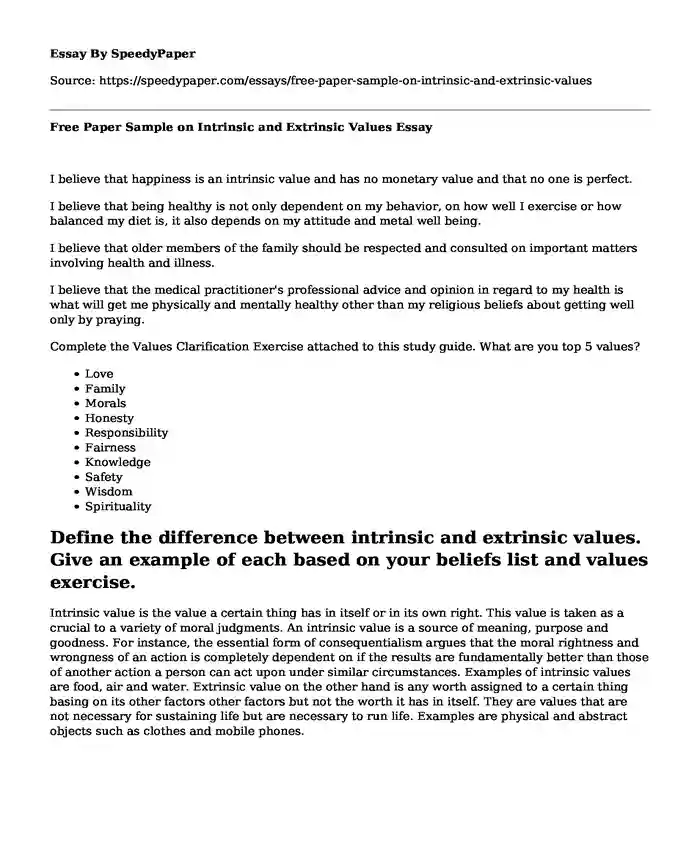
| Type of paper: | Course work |
| Categories: | Human development |
| Pages: | 3 |
| Wordcount: | 681 words |
I believe that happiness is an intrinsic value and has no monetary value and that no one is perfect.
I believe that being healthy is not only dependent on my behavior, on how well I exercise or how balanced my diet is, it also depends on my attitude and metal well being.
I believe that older members of the family should be respected and consulted on important matters involving health and illness.
I believe that the medical practitioner's professional advice and opinion in regard to my health is what will get me physically and mentally healthy other than my religious beliefs about getting well only by praying.
Complete the Values Clarification Exercise attached to this study guide. What are you top 5 values?
- Love
- Family
- Morals
- Honesty
- Responsibility
- Fairness
- Knowledge
- Safety
- Wisdom
- Spirituality
Define the difference between intrinsic and extrinsic values. Give an example of each based on your beliefs list and values exercise.
Intrinsic value is the value a certain thing has in itself or in its own right. This value is taken as a crucial to a variety of moral judgments. An intrinsic value is a source of meaning, purpose and goodness. For instance, the essential form of consequentialism argues that the moral rightness and wrongness of an action is completely dependent on if the results are fundamentally better than those of another action a person can act upon under similar circumstances. Examples of intrinsic values are food, air and water. Extrinsic value on the other hand is any worth assigned to a certain thing basing on its other factors other factors but not the worth it has in itself. They are values that are not necessary for sustaining life but are necessary to run life. Examples are physical and abstract objects such as clothes and mobile phones.
Define overt versus covert values. Which of your values have formed as covert values and which overt values (or give examples of these)?
Overt values are values held by groups, individuals and organized systems that are explicitly communicated through policies and statements. My overt value is that it is wrong to kill and it has been blatantly expressed to me by statements and laws. Covert values on the other hand are expectations identified only by taking part in or controversies within an institution which are not written down. My covert value is I always have my brothers' backs. This is not something I was instructed or told to do by any law, it is rather a thing that I came to realize was part of my family' values.
What are your thoughts regarding the Origins of Morality research as seen in the video? What similarities are evident in this video compared with the moral developmental theory of Gilligan and Kohlberg? What are the differences? How do you think understanding moral development might affect your understanding of ethics?
My thoughts in regard to the origins of Morality research in the video is that babies are human beings and would unconsciously develop a bias favor to themselves. However it is upon the society to educate them and shape their perceptions about important virtues. It is these virtues that shape their lives as they develop. Kohlberg's theory of morality evolution is founded on the belief that human beings base on their universal, logic, conceptual values of justice, obligation and unbiased reasoning to make decisions (Krebs et al., 2014). However, Gilligan's ethic of care belief is founded on the basic principle that the values, psychology and ethical structure of females is different from that of the males. She holds that women are intrinsically disposed to responsibility and care towards others (Larrabee, 2016). The two both acknowledge the idea of developmental morality and Gilligan's theory is an expansion of Kohlberg's theory, despite her controversial opinion regarding it.
References
Larrabee, M. J. (2016). An ethic of care: Feminist and interdisciplinary perspectives. Routledge.
Krebs, D. L., Vermeulen, S., Carpendale, J., & Denton, K. (2014). Structural and situational influences on moral judgment: The interaction between stage and dilemma. en: WM Kurtines et JL Gewirtz (eds.): Handbook of moral behavior and development, 1, 139-169.
Cite this page
Free Paper Sample on Intrinsic and Extrinsic Values. (2022, Sep 12). Retrieved from https://speedypaper.com/essays/free-paper-sample-on-intrinsic-and-extrinsic-values
Request Removal
If you are the original author of this essay and no longer wish to have it published on the SpeedyPaper website, please click below to request its removal:
- Free Essay Describing The Chandler Mall
- Ethics of Religion - Free Essay Sample
- Free Essay about Tax Issues of Withdrawing Assets
- Internal Communication Systems within an Organization - Free Essay with Research Proposal
- The Birth of Human, Essay Example in Philosophy
- Free Essay about the Importance of Good Posture for Health
- Paper Example on Evaluation of Humphry's Essay
Popular categories




